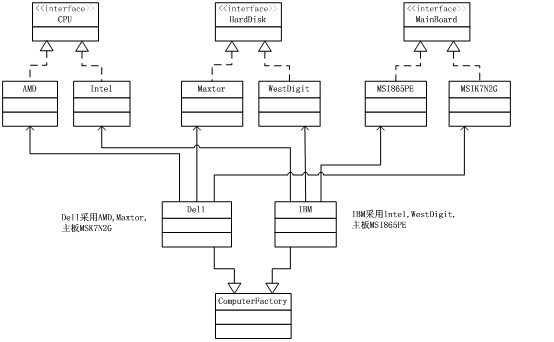Abstract Factory Pattern(抽象工厂模式)
抽象工厂就是一要一种关联耦合设计成一个抽象类。抽象工厂模式符合GRASP的纯虚构模式,同时取得高内聚低耦合的效果。
其UML类图如下:

其中的类或对象之间的关系为:
AbstractFactory(抽象工厂):声明生成抽象产品的方法。
ConcreteFactory(具体工厂):执行生成抽象产品的方法,生成一个具体的产品。
AbstractProduct(抽象产品):为一种产品声明接口。
Product(具体产品):定义具体工厂生成的具体产品的对象,实现产品接口。
Client(客户):我们的应用程序,使用抽象产品和抽象工厂生成对象。
Java实例——电脑产品

首先,定义CPU接口:
public interface CPU {
public StringgetCPU();
}
定义AMD类,实现CPU接口:
public class AMD implements CPU{
@Override
public String getCPU() {
// TODO Auto-generated method stub
return "Athlon XP2800+";
}
}
定义Intel类,实现CPU接口:
public class Intel implements CPU{
@Override
public StringgetCPU() {
// TODO Auto-generated method stub
return "奔腾4 3.2C";
}
}
定义硬盘接口:
public interface HardDisk {
public StringgetSize();
}
定义Maxtor类,实现硬盘接口:
public class Maxtor implements HardDisk{
@Override
public StringgetSize() {
// TODO Auto-generated method stub
return "MaxLine Plus II 200G";
}
}
定义WestDigit类,实现硬盘接口:
public class WestDigit implements HardDisk{
@Override
public StringgetSize() {
// TODO Auto-generated method stub
return "WD2500JD 250G";
}
}
定义主板的接口,包含参数为CPU的公共方法Attach():
public interface MainBoard {
public voidAttach(CPU cpu) throws Exception;
}
主板微星MSI865PE,支持Intel的CPU:
public class MSI865PE implements MainBoard{
@Override
public voidAttach(CPU cpu) throws Exception {
// TODO Auto-generated method stub
if(cpu.getClass().toString().endsWith("Intel")){
System.out.println("MSI865PE");
}
else {
throw newException("主板MSI865PE只能配Intel的CPU");
}
}
}
主板微星MSIK7N2G,支持AMD的CPU:
public class MSIK7N2G implements MainBoard{
@Override
public voidAttach(CPU cpu) throws Exception {
// TODO Auto-generated method stub
if(cpu.getClass().toString().endsWith("AMD")){
System.out.println("MSIK7N2G");
}
else {
throw newException("主板MSIK7N2G只能配AMD的CPU");
}
}
}
定义抽象电脑工厂类:
Publicabstract classComputerFactory {
CPU cpu;
HardDisk hd;
MainBoard mb;
public voidshow(){
try {
System.out.println(this.getClass().getName().toString()+"生产的电脑配置");
System.out.println("CPU:"+cpu.getCPU());
System.out.println("HardDisk:"+hd.getSize());
System.out.print("MainBoard:");
mb.Attach(cpu);
} catch(Exception e) {
// TODO: handle exception
System.out.println(e.getMessage());
}
}
}
抽象电脑工厂类派生类IBM,定义其返回的系列配件产品:
public class IBM extends ComputerFactory{
IBM()
{
cpu=newIntel();
hd=newWestDigit();
mb=newMSI865PE();
}
}
抽象电脑工厂类派生类Dell,定义其返回的系列配件产品:
public class Dell extends ComputerFactory{
Dell() {
// TODO Auto-generated constructor stub
cpu=new AMD();
hd=newMaxtor();
mb=newMSIK7N2G();
}
}
客户程序调用:
public class Client {
public static voidmain(String[] args){
IBM ibm=new IBM();
ibm.show();
Dell dell=newDell();
dell.show();
}
}
输出结果为:
abstract_factory_pattern.IBM生产的电脑配置
CPU:奔腾4 3.2C
HardDisk:WD2500JD250G
MainBoard:MSI865PE
abstract_factory_pattern.Dell生产的电脑配置
CPU:Athlon XP 2800+
HardDisk:MaxLinePlus II 200G
MainBoard:MSIK7N2G
应用情景:
1. 系统需要屏蔽有关对象如何创建、如何组织和如何表示。
2. 系统需要由关联的多个对象来构成。
3. 有关联的多个对象需要一起应用并且它们的约束是强迫的(不可分离)。
4. 你想提供一组对象而不显示它们的实现过程,只显示它们的接口。






















 1071
1071

 被折叠的 条评论
为什么被折叠?
被折叠的 条评论
为什么被折叠?








